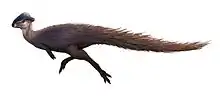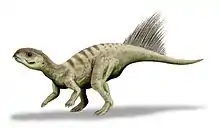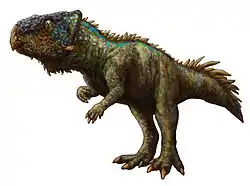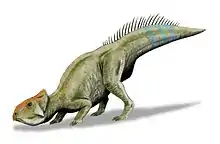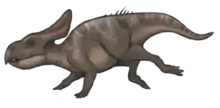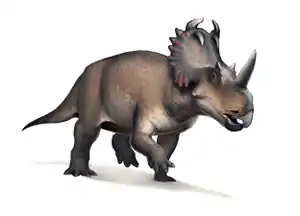Pachyrhinosaurini
Pachyrhinosaurini was a tribe of centrosaurine dinosaurs. The clade existed during the Late Cretaceous, about 84.9 to 66 million years ago, evolving during the earliest Campanian,[2] and becoming extinct in the Maastrichtian.[3][4] The tribe contains three genera: Einiosaurus, Achelousaurus, and Pachyrhinosaurus. Pachyrhinosaurus and Achelousaurus form the clade of pachyrhinosaurins called the Pachyrostra ("thick-snouts"), characterized primarily by their nasal bosses.
| Pachyrhinosaurini | |
|---|---|
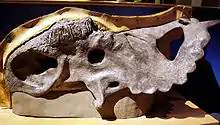 | |
| Skull of a Pachyrhinosaurus canadensis | |
| Scientific classification | |
| Kingdom: | Animalia |
| Phylum: | Chordata |
| Clade: | Dinosauria |
| Order: | †Ornithischia |
| Family: | †Ceratopsidae |
| Subfamily: | †Centrosaurinae |
| Clade: | †Eucentrosaura |
| Tribe: | †Pachyrhinosaurini Fiorillo & Tykoski, 2012 |
| Type species | |
| †Pachyrhinosaurus canadensis | |
| Subdivisions[1] | |
| |
Classification
Pachyrhinosaurini was defined in 2012 by Fiorillo & Tykoski. It was defined as all centrosaurine ceratopsids more closely related to Pachyrhinosaurus canadensis than to Centrosaurus apertus. It was defined during the description of Pachyrhinosaurus perotorum, a species from Alaska.[3]
The cladogram below represents the findings of Lund et al., 2016, in their description of Machairoceratops cronusi. Wendiceratops pinhornensis, Xenoceratops foremostensis, and Sinoceratops zhuchengensis were resolved as members of the Pachyrhinosaurini and Einiosaurus was resolved as a pachyrostran and the sister taxon of Achelousaurus.
| Ceratopsidae |
| ||||||||||||||||||||||||||||||||||||||||||||||||||||||||||||||||||||||||||||||||||||||||||||||||||||||||||||
The cladogram below represents a more recent phylogenetic analysis that included Pachyrhinosaurini by Chiba et al. (2017). Wendiceratops, Xenoceratops, and Sinoceratops were not resolved as members of the Pachyrhinosaurini and Einiosaurus was not resolved as a pachyrostran.[5]
| Centrosaurinae |
| |||||||||||||||||||||||||||||||||||||||||||||||||||||||||||||||||||||||||||||||||||||||||||||||||||||||||||||||
See also
References
- Sampson, S.D.; Lund, E.K.; Loewen, M.A.; Farke, A.A.; Clayton, K.E. (2013). "A remarkable short-snouted horned dinosaur from the Late Cretaceous (late Campanian) of southern Laramidia". Proceedings of the Royal Society B. 1766. 280 (1766): 4. doi:10.1098/rspb.2013.1186. PMC 3730592. PMID 23864598.
- Gilmore, C.W. (1930). "On dinosaurian reptiles from the Two Medicine Formation of Montana". Proceedings of the United States National Museum. 77 (16): 1–39. doi:10.5479/si.00963801.77-2839.1.
- Fiorillo, A.R. & Tykoski, R.S. (2012). "A new Maastrichtian species of the centrosaurine ceratopsid Pachyrhinosaurus from the North Slope of Alaska". Acta Palaeontologica Polonica. 57 (3): 561. doi:10.4202/app.2011.0033.CS1 maint: uses authors parameter (link)
- Fiorillo, A.R. & Gangloff, R.A. (2001). "Theropod teeth from the Prince Creek Formation (Cretaceous) of northern Alaska, with speculations on Arctic dinosaur paleoecology". Journal of Vertebrate Paleontology. 20 (4): 675–682. doi:10.1671/0272-4634(2000)020[0675:TTFTPC]2.0.CO;2.CS1 maint: uses authors parameter (link)
- Kentaro Chiba; Michael J. Ryan; Federico Fanti; Mark A. Loewen; David C. Evans (2018). "New material and systematic re-evaluation of Medusaceratops lokii (Dinosauria, Ceratopsidae) from the Judith River Formation (Campanian, Montana)". Journal of Paleontology. in press (2): 272–288. doi:10.1017/jpa.2017.62.
